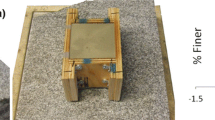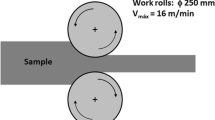Abstract
A series of direct shear tests on specimens with artificial joints were performed to investigate the rate-dependent characteristics of damage and roughness degradation of three-dimensional joint surfaces under different normal stresses and shear velocities. A novel method was proposed to identify and extract the damaged area of joint surfaces based on the combination of the three-dimensional scanning technology and the color image segmentation method. Based on the proposed method, two main failure modes were identified on the joint surface, including asperity wear and debris backfilling. By controlling different shear displacements and shear velocities, the rate-dependent damage evolution of the joint surface during shearing was revealed. Four damage states are defined to better understand the local damage mechanism of joints. The statistical results indicate that the damage area ratio increases with increasing normal stress and shear velocity. The damage develops more rapidly at a higher shear velocity during progressive shearing. Furthermore, the three-dimensional roughness parameter \({\theta }_{\mathrm{max}}^{*}/(C+1)\) is measured in 36 analysis directions on the sheared joint surfaces to quantitatively describe the asperity degradation. It is observed that the average roughness parameter increases with increasing shear velocity under the same normal stress but decreases with increasing shear displacement. The results in the present study may provide some references for revealing the mechanical behavior and damage state of joints subjected to dynamic loads.
Highlights
-
A new method is proposed to identify and extract the damage area of joint surfaces based on the three-dimensional scanning technology and the color image segmentation method.
-
The damage area ratio increases with increasing normal stress and shear velocity.
-
The damage develops more rapidly at a higher shear velocity during progressive shearing compared with that at a lower shear velocity.
-
The three-dimensional roughness parameter is measured in 36 analysis directions on the sheared joint surfaces to quantitatively describe the asperity degradation.





















Similar content being viewed by others
References
Asadi MS, Rasouli V, Barla G (2013) A laboratory shear cell used for simulation of shear strength and asperity degradation of rough rock fractures. Rock Mech Rock Eng 46:683–699. https://doi.org/10.1007/s00603-012-0322-2
Atapour H, Moosavi M (2013) The influence of shearing velocity on shear behavior of artificial joints. Rock Mech Rock Eng 47:1745–1761. https://doi.org/10.1007/s00603-013-0481-9
Bahaaddini M, Sharrock G, Hebblewhite BK (2013) Numerical direct shear tests to model the shear behaviour of rock joints. Comput Geotech 51:101–115. https://doi.org/10.1016/j.compgeo.2013.02.003
Bahaaddini M, Hagan PC, Mitra R, Khosravi MH (2016) Experimental and numerical study of asperity degradation in the direct shear test. Eng Geol 204:41–52. https://doi.org/10.1016/j.enggeo.2016.01.018
Bao H, Zhang G, Lan H, Yan C, Xu J, Xu W (2020) Geometrical heterogeneity of the joint roughness coefficient revealed by 3D laser scanning. Eng Geol 265:105415. https://doi.org/10.1016/j.enggeo.2019.105415
Barton N, Choubey V (1977) The shear strength of rock joints in theory and practice. Rock Mech 10:1–54. https://doi.org/10.1007/BF01261801
Chen SJ, Zhu WC, Yu QL, Liu XG (2015) Characterization of anisotropy of joint surface roughness and aperture by variogram approach based on digital image processing technique. Rock Mech Rock Eng 49:855–876. https://doi.org/10.1007/s00603-015-0795-x
Chern SG, Cheng TC, Chen WY (2012) Behavior of regular triangular joints under cyclic shearing. J Mar Sci Tech-Taiw 20:508–513. https://doi.org/10.6119/Jmst-011-0428-1
Crawford AM, Curran JH (1981) The influence of shear velocity on the frictional resistance of rock discontinuities. Int J Rock Mech Min Sci 18:505–515. https://doi.org/10.1016/0148-9062(81)90514-3
De Silva VRS, Ranjith PG (2020) A study of rock joint influence on rock fracturing using a static fracture stimulation method. J Mech Phys Solids 137:103817. https://doi.org/10.1016/j.jmps.2019.103817
Fathi A, Moradian Z, Rivard P, Ballivy G, Boyd AJ (2015) Geometric effect of asperities on shear mechanism of rock joints. Rock Mech Rock Eng 49:801–820. https://doi.org/10.1007/s00603-015-0799-6
Ge Y, Kulatilake PHSW, Tang H, Xiong C (2014) Investigation of natural rock joint roughness. Comput Geotech 55:290–305. https://doi.org/10.1016/j.compgeo.2013.09.015
Grasselli G, Wirth J, Egger P (2002) Quantitative three-dimensional description of a rough surface and parameter evolution with shearing. Int J Rock Mech Min Sci 39:789–800. https://doi.org/10.1016/s1365-1609(02)00070-9
Gui Y, Xia C, Ding W, Qian X, Du S (2017) A new method for 3D modeling of joint surface degradation and void space evolution under normal and shear loads. Rock Mech Rock Eng 50:2827–2836. https://doi.org/10.1007/s00603-017-1242-y
Gui Y, Xia C, Ding W, Qian X, Du S (2018) Modelling shear behaviour of joint based on joint surface degradation during shearing. Rock Mech Rock Eng 52:107–131. https://doi.org/10.1007/s00603-018-1581-3
He W, Hayatdavoudi A, Shi H, Sawant K, Huang P (2019) A preliminary fractal interpretation of effects of grain size and grain shape on rock strength. Rock Mech Rock Eng 52:1745–1765. https://doi.org/10.1007/s00603-018-1645-4
He L, Zhao Z, Chen J, Liu D (2020) Empirical shear strength criterion for rock joints based on joint surface degradation characteristics during shearing. Rock Mech Rock Eng 53:3609–3624. https://doi.org/10.1007/s00603-020-02120-4
Hong E-S, Kwon T-H, Song K-I, Cho G-C (2015) Observation of the degradation characteristics and scale of unevenness on three-dimensional artificial rock joint surfaces subjected to shear. Rock Mech Rock Eng 49:3–17. https://doi.org/10.1007/s00603-015-0725-y
Huang TH, Chang CS, Chao CY (2002) Experimental and mathematical modeling for fracture of rock joint with regular asperities. Eng Fract Mech 69:1977–1996
Indraratna B, Thirukumaran S, Brown ET, Premadasa W, Gale W (2014) A technique for three-dimensional characterisation of asperity deformation on the surface of sheared rock joints. Int J Rock Mech Min Sci 70:483–495. https://doi.org/10.1016/j.ijrmms.2014.04.022
ISRM (2007) The Complete ISRM suggested methods for rock characterization, testing and monitoring: 1974–2006. In: Ulusay R, Hudson JA (eds) Suggested methods prepared by the commission on testing methods. International Society for Rock Mechanics, ISRM Turkish National Group, Ankara, Turkey. p 628
Ji Y, Wu W (2020) Injection-driven fracture instability in granite: Mechanism and implications. Tectonophysics 791:228572. https://doi.org/10.1016/j.tecto.2020.228572
Jiang Q, Feng X, Gong Y, Song L, Ran S, Cui J (2016) Reverse modelling of natural rock joints using 3D scanning and 3D printing. Comput Geotech 73:210–220. https://doi.org/10.1016/j.compgeo.2015.11.020
Jiang MJ, Liu J, Crostad GB, Li T (2017) DEM analysis of the effect of joint geometry on the shear behavior of rocks. CR Mecanique 345:779–796. https://doi.org/10.1016/j.crme.2017.07.004
Jing L, Nordlund E, Stephansson O (1992) An experimental-study on the anisotropy and stress-dependency of the strength and deformability of rock joints. Int J Rock Mech Min Sci Geomech Abstr 29:535–542. https://doi.org/10.1016/0148-9062(92)91611-8
Kou M, Liu X, Tang S, Wang Y (2019) Experimental study of the prepeak cyclic shear mechanical behaviors of artificial rock joints with multiscale asperities. Soil Dyn Earthq Eng 120:58–74. https://doi.org/10.1016/j.soildyn.2019.01.026
Li Y, Wu W, Li B (2018) An analytical model for two-order asperity degradation of rock joints under constant normal stiffness conditions. Rock Mech Rock Eng 51:1431–1445. https://doi.org/10.1007/s00603-018-1405-5
Li Y, Wu W, Ca T, Liu B (2019) Predicting the shear characteristics of rock joints with asperity degradation and debris backfilling under cyclic loading conditions. Int J Rock Mech Min Sci 120:108–118. https://doi.org/10.1016/j.ijrmms.2019.06.001
Liu Q, Tian Y, Ji P, Ma H (2017) Experimental investigation of the peak shear strength criterion based on three-dimensional surface description. Rock Mech Rock Eng 51:1005–1025. https://doi.org/10.1007/s00603-017-1390-0
Liu X, Zhu W, Yu Q, Chen S, Guan K (2018) Estimating the joint roughness coefficient of rock joints from translational overlapping statistical parameters. Rock Mech Rock Eng 52:753–769. https://doi.org/10.1007/s00603-018-1643-6
Mei C, Barbot S, Wu W (2021) Period-multiplying cycles at the transition between stick-slip and stable sliding and implications for the parkfield period-doubling tremors. Geophys Res Lett 48(7):e2020GL091807. https://doi.org/10.1029/2020GL091807
Meng F, Zhou H, Wang Z, Zhang C, Li S, Zhang L, Kong L (2017) Characteristics of asperity damage and its influence on the shear behavior of granite joints. Rock Mech Rock Eng 51(2):429–449. https://doi.org/10.1007/s00603-017-1315-y
Meng F, Wong LNY, Zhou H, Wang Z, Zhang L (2020) Asperity degradation characteristics of soft rock-like fractures under shearing based on acoustic emission monitoring. Eng Geol 266:105392. https://doi.org/10.1016/j.enggeo.2019.105392
Niktabar SMM, Rao KS, Shrivastava AK (2017) Effect of rock joint roughness on its cyclic shear behavior. J Rock Mech Geotech Eng 9(6):1071–1084. https://doi.org/10.1016/j.jrmge.2017.09.001
Plesha ME (1987) Constitutive models for rock discontinuities with dilatancy and surface degradation. Int J Numer Anal Methods Geomech 11:345–362. https://doi.org/10.1002/nag.1610110404
Shang J, Zhao Z, Ma S (2018) On the shear failure of incipient rock discontinuities under CNL and CNS boundary conditions: Insights from DEM modelling. Eng Geol 234:153–166. https://doi.org/10.1016/j.enggeo.2018.01.012
Tang ZC, Wong LNY (2015) Influences of normal loading rate and shear velocity on the shear behavior of artificial rock joints. Rock Mech Rock Eng 49:2165–2172. https://doi.org/10.1007/s00603-015-0822-y
Tatone BS, Grasselli G (2009) A method to evaluate the three-dimensional roughness of fracture surfaces in brittle geomaterials. Rev Sci Instrum 80(12):125110. https://doi.org/10.1063/1.3266964
Tatone BSA, Grasselli G (2010) A new 2D discontinuity roughness parameter and its correlation with JRC. Int J Rock Mech Min Sci 47:1391–1400. https://doi.org/10.1016/j.ijrmms.2010.06.006
Wang WB, Scholz CH (1994) Micromechanics of the velocity and normal stress dependence of rock friction. Pure Appl Geophys 143:303–315. https://doi.org/10.1007/Bf00874333
Wang G, Zhang X, Jiang Y, Wu X, Wang S (2016) Rate-dependent mechanical behavior of rough rock joints. Int J Rock Mech Min Sci 83:231–240. https://doi.org/10.1016/j.ijrmms.2015.10.013
Wang C, Wang L, Karakus M (2019) A new spectral analysis method for determining the joint roughness coefficient of rock joints. Int J Rock Mech Min Sci 113:72–82. https://doi.org/10.1016/j.ijrmms.2018.11.009
Yang J, Rong G, Hou D, Peng J, Zhou C (2016) Experimental study on peak shear strength criterion for rock joints. Rock Mech Rock Eng 49:821–835. https://doi.org/10.1007/s00603-015-0791-1
Zhang X, Jiang Q, Chen N, Wei W, Feng X (2016) Laboratory investigation on shear behavior of rock joints and a new peak shear strength criterion. Rock Mech Rock Eng 49:3495–3512. https://doi.org/10.1007/s00603-016-1012-2
Zhang G, Karakus M, Tang H, Ge Y, Jiang Q (2017) Estimation of joint roughness coefficient from three-dimensional discontinuity surface. Rock Mech Rock Eng 50:2535–2546. https://doi.org/10.1007/s00603-017-1264-5
Zhang X, Jiang Y, Wang G, Liu J, Wang D, Wang C, Sugimoto S (2018) Mechanism of shear deformation, failure and energy dissipation of artificial rock joint in terms of physical and numerical consideration. Geosci J 23:519–529. https://doi.org/10.1007/s12303-018-0043-y
Zhang Q, Wu C, Fei X, Jang BA, Liu D (2019) Time-dependent behavior of rock joints considering asperity degradation. J Struct Geol 121:1–9. https://doi.org/10.1016/j.jsg.2019.01.004
Zhao Z, Peng H, Wu W, Chen Y-F (2018) Characteristics of shear-induced asperity degradation of rock fractures and implications for solute retardation. Int J Rock Mech Min Sci 105:53–61. https://doi.org/10.1016/j.ijrmms.2018.03.012
Zheng B, Qi S (2016) A new index to describe joint roughness coefficient (JRC) under cyclic shear. Eng Geol 212:72–85. https://doi.org/10.1016/j.enggeo.2016.07.017
Acknowledgements
The study was funded by the National Natural Science Foundation of China (Grant Nos. 51679231 and 51439008).
Author information
Authors and Affiliations
Corresponding author
Additional information
Publisher's Note
Springer Nature remains neutral with regard to jurisdictional claims in published maps and institutional affiliations.
Rights and permissions
About this article
Cite this article
Shen, H., Liu, Y., Li, H. et al. Rate-Dependent Characteristics of Damage and Roughness Degradation of Three-Dimensional Artificial Joint Surfaces. Rock Mech Rock Eng 55, 2221–2237 (2022). https://doi.org/10.1007/s00603-022-02770-6
Received:
Accepted:
Published:
Issue Date:
DOI: https://doi.org/10.1007/s00603-022-02770-6




